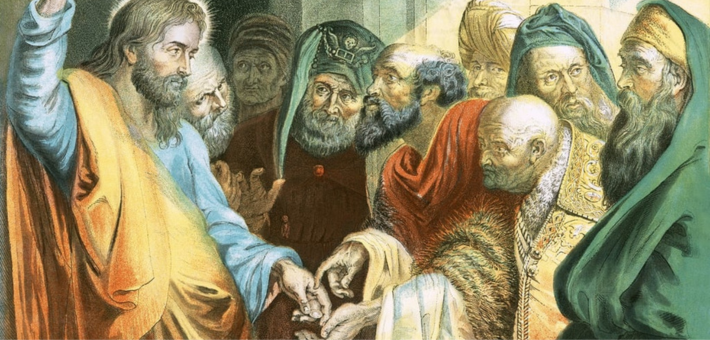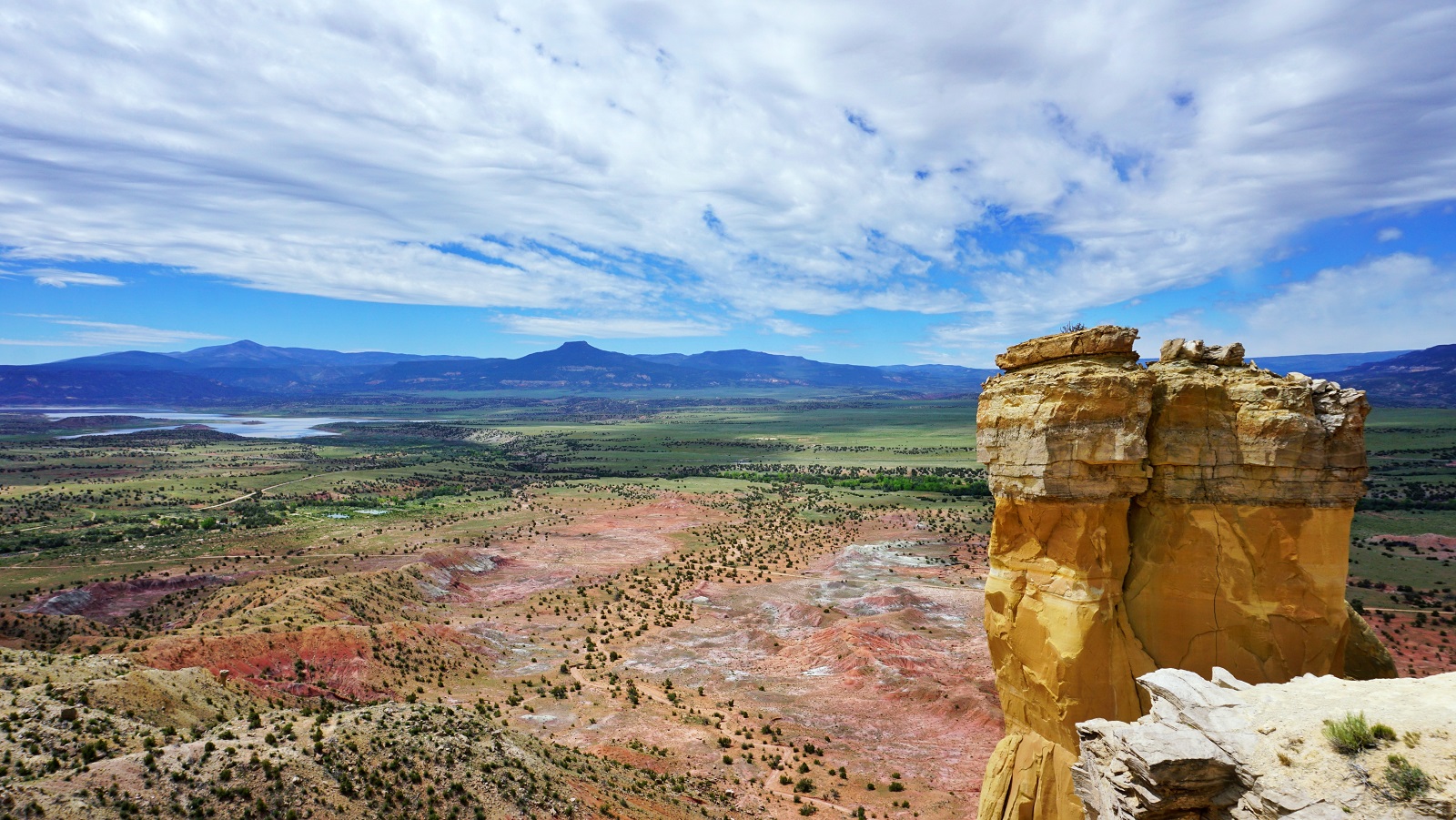Commentary on Exodus 33:12-23
I was preparing to teach a Confirmation Class in which I would ask each student how they imagine God. While I was divvying out markers and large pieces of butcher paper on the floor of the youth room, a church volunteer came by with her four-year-old child. “What are you doing?” the boy wanted to know. I explained and asked him what he thought God looked like. I can still hear his profound response, complete with his age-appropriate inability to pronounce the letters “l” and “r,” which both sounded like “w.” “A giant rainbow cloud.”
This child’s perceptive response aligns well with biblical accounts, which similarly provide non-physical descriptions of the deity. Exodus 33:12-23 holds a central place in the list of biblical theophanies, or personal encounters with the Holy One, which start with the first humans in Genesis 2-3, and continue with Abram (Genesis 12:7), Hagar (Genesis 16:13), and Moses, along with many others throughout the canon. Exodus contains multiple theophanies, mostly associated with the Holy Mountain (identified as Horeb in some places and Sinai in others). Moses famously encounters the Holy One in a burning bush that was not consumed (Exodus 3:2); in Exodus 19 God’s presence appears amid thunder, lightning, cloud, and fire, while Exodus 24:10 offers the simultaneously specific and evasive phrase “something like a pavement of sapphire stone” on which God stood.
One of the most striking statements in this passage reports the LORD saying, “You cannot see my face; for no one shall see me and live.” This theology plays out in that iconic scene from the finale of Raiders of the Lost Ark (1981, Paramount)–those who know enough to look away from the opened ark’s manifestation of holiness do so, and they are the only ones whose faces do not melt. This is the epitome of pop culture teaching biblical principles!
A deeper dive into the biblical books shows that the ancient people of God had differences of opinion on whether one could see God and live. Only nine verses earlier, in 33:11, we read “the LORD used to speak to Moses face to face, as one speaks to a friend.” Scholars have identified such differences of theological opinion as pointing to various traditions or even sources produced by sub-groups of ancient Israelites.
Dr. Benjamin D. Sommer has pointed out how differing ancient views about God provide analogies to contemporary theological debates.¹ We could be comforted by the idea that we are not the first community of faith to struggle with conflicting understandings of God. We could also let this teach us about how to deal with disputed issues. Our ancestors in faith did not take a vote to determine whether the text would retain a “you cannot see God and live”-only view, over against a “some people can see some parts of God” view. Rather, they retained both views, side by side, woven into our compelling, complex, sacred texts.
Just before this passage, the LORD had instructed Moses and the people to finally leave the Holy Mountain. This marks a significant change in geography and content for the remainder of the Pentateuch. Moses and the people have received the divine teachings and now will commence an epic journey of wilderness wandering. As with most transition points for all of us, this raises concerns and anxiety. Understandably, it prompts many questions from Moses for God.
Moses does not hesitate to rehearse his misgivings, questions, or challenges of God.
We can learn something from Moses here. Even God’s hand-picked leader does not refrain from expressing his concerns to the Divine. He asks the LORD in the opening verse who will go with him on this epic journey. Practically in the same breath he also implores, “make your ways known to me” (33:13). The Holy One reassures Moses that God will cause the people to “rest”—which has a deeper meaning than napping. This term indicates that the LORD’s “presence” will ensure the people freedom from warfare and suffering. The word for “presence” is the same one translated “face” in verses 20 and 23. Thus the “presence” that Moses is assured of as company is also the “face” that he cannot be allowed to see. This passage itself contains some of that theological ambiguity about whether one really could see God and live!
Despite this emphatic reassurance of God’s support/solidarity with Moses and the people, Moses almost belligerently persists with his doubt-riddled line of questioning: Do not make us go if you do not go with us; we cannot trust in your “favor” without your actual presence. Again, the LORD reassures Moses—both he and the people have God’s “favor” (verse 17)—but still, Moses pressures the Holy One: “Please, make me see your glory!” (verse 18, my translation). Here, it would seem, Moses surely has crossed a line from doubtful to cheeky. How much reassurance does this guy require?
If the Holy One were impatient, Moses surely would have been struck by lightning by now. Instead, we have an intimate back-and-forth of questions (12, 13 twice, 15, 16, 18) and reassurances (verses 14, 17, 19 twice, 20). Though the LORD and Moses have a history of exchanging names (verses 12, 17), Moses’ persistence pays off with a final revelation of the Divine Name* and Nature (verse 19). Having first been protected from the dangerous power of this encounter, Moses catches a fleeting glimpse of the LORD’s back on the way. The Holy One is at once protective and revelatory. No ancient deity worthy of worship would have been anything other than dangerous, otherwise what good would they be in times of trouble? Thus, Moses’ demanding questions contain risk. How can he find reassurance without being destroyed in the process? Perhaps that is what he learned in this divine self-revelation: This is a God who shows “favor” to Moses and his people; a God whose prerogative it is to be “gracious,” and “show mercy.”
*As a post-script, though one quite related to the topic at hand, I encourage Christian clergy to stand in solidarity with our Jewish sisters and brothers by participating in the tradition of not pronouncing the holy, unspeakable, divine name. Longstanding Jewish tradition is to pronounce the tetragrammaton “Adonai,” while more contemporary practice includes the option of “ha-Shem,” or “the name.” This divine name is typically rendered “LORD” (in small caps) in contemporary English Christian translations. This tradition itself embodies the dilemma of the Holy One as both immanent and transcendent; present and distant; close enough to almost see while dangerous enough to protect us from that encounter; both speakable and unspeakable.
Notes:
- “The Source Critic and the Religious Interpreter” https://www.thetorah.com/article/the-source-critic-and-the-religious-interpreter



October 22, 2023